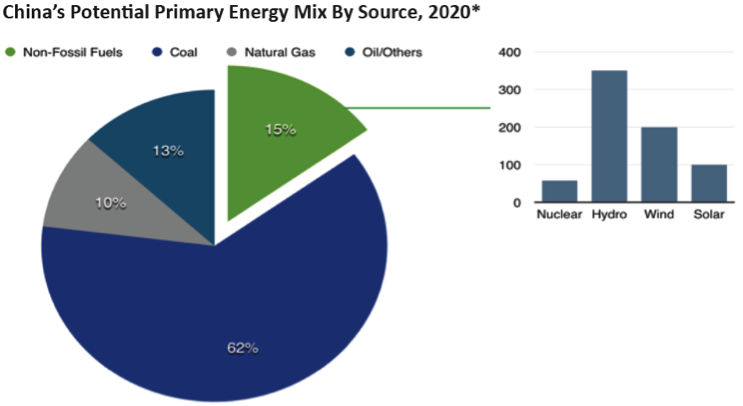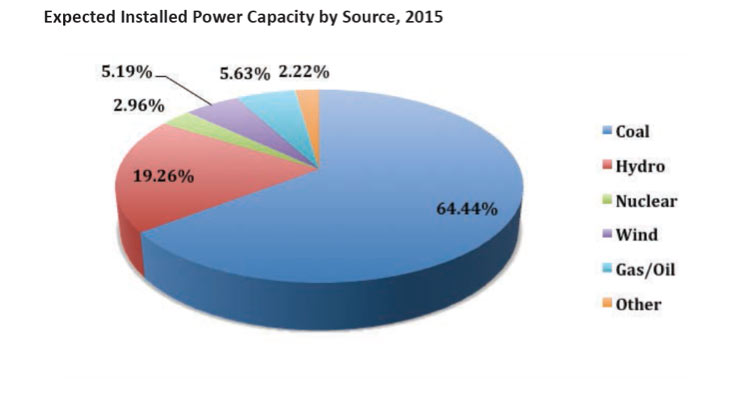Stephen Zhao
The Paulson Institute recently released a paper by Damien Ma entitled “Rebalancing China’s Energy Strategy” as the inaugural paper of the Paulson Institute’s Energy and Environment series. Ma provides a strong overview of the current energy situation in China and identifies a link between energy strategy and China’s commitments to climate change. Although his paper highlights key insights regarding Chinese energy strategy, there are a number of important implications these insights hold for Chinese climate change policy that the paper fails to touch upon.


Pictures taken from “Rebalancing China’s Energy Strategy”
Highlights:
Everything but Coal:
Coal use in China is declining, but its use remains dominant and needs to decline further in China to reach an environmentally sustainable path of development. In response to this need, China is currently embarking on an “everything but coal” policy, diversifying its energy portfolio away from coal as a supply side solution to energy consumption impact on the environment. Nevertheless, coal-based energy production is attaining a high level of efficiency so improving energy intensity by shutting down inefficient coal plants is no longer a simple solution to China’s carbon dioxide emissions.
Diversification:
Chinese diversification away from coal has numerous positive effects. The transition is paving the way for new energy industries in solar and wind power. The process of converting to other fuels is reducing carbon emissions and other forms of pollution, and the environmentally-friendly taxes on coal can serve as a source of revenue for increasingly cash-strapped local Chinese government budgets. The attempt to shift away from coal has resulted in a rapid development in renewable energy in China.
Curbing Demand:
With energy demand rising so rapidly in China, supply-side measures such as changing the energy profile in China are not sufficient, however, to solve pollution issues. Ma contends that China needs to reduce consumer demand, which should be done through measures such as raising the marketization of electricity prices and more stringent fuel economy standards for vehicles.
Climate Change:
China is signalling that it wishes to undertake greater responsibility in climate change through actions such as its joint announcement on climate change with the United States, where China made a commitment to peak carbon emissions by 2030. This represents a break from India, Brazil, and other developing countries, and may even alienate China from these states in the realm of climate policy. However, this break is based on domestic concerns regarding air pollution and not external pressures.
Contentions and Implications:
Chinese Climate Change Commitments
Ma mentions a number of details regarding changes in China’s commitments to combat climate change that might be explained in further detail. While China has announced a commitment to peak its carbon emissions by 2030, there has yet to be concrete plans to achieve this goal. There is an understanding amongst certain members of the Chinese government that this goal will be achieved with current policies, but a recent study by Tsinghua University and MIT suggests that current policies will put China’s emissions peak in 2040 instead.
However, while there is no released plan as of yet, Chinese commitment to combating climate change is rooted in powerful domestic determinants. As Ma suggests: domestic concern over air pollution is high, and cutting carbon emissions has the additional benefit of reducing the amount of smog. Beyond the public concern over pollution, the public is also highly supportive of measures to contain climate change. A study done by Yale University revealed that 89% of Chinese agree and 9% somewhat agree that “the government should pay great attention to the issue of climate change.” There is also significant high-level pressure from the Chinese government that has been repeatedly cited by officials as one of their primary motivations for progress on climate change. Indeed, Premier Li Keqiang himself served as chairperson of the China Council for International Cooperation on Environment and Development and maintains a strong attachment to the success of the organization.
Carbon Trading
Ma neglected to mention that China has already announced the implementation of a national emissions trading scheme (ETS) in August 31, 2014. Originally slated for implementation in 2020, the national ETS has been advanced for implementation in 2016. In light of the November 2014 announcement to achieve peak emissions by 2030, the early implantation of the ETS may be one step that China is taking to fulfil this commitment. The national trading scheme expands upon the seven pilot emissions trading programs currently in operation. The pilots have demonstrated success in innovative measures such as indirect emissions coverage to prevent carbon leakage, shown the viability of emission trading schemes within low-income environments, and experienced relatively strong prices when compared to other emissions trading schemes around the world. However, there is a liquidity issue within the Chinese pilots and uncertainty with monitoring, reporting, and verification (MRV) setup that will need to be addressed in the design of the national scheme.
Electricity
One of the strengths of China’s emissions trading system is the synergy between electricity pricing mechanisms and emissions trading. Ma criticized China’s electricity market for the presence of state intervention, which creates prices that do not reflect the “market equilibrium.” However, state controlled electricity prices can indeed be a strength. Considering the high capital costs of electricity generation, electricity prices are naturally oligopolistic and firms possess significant market power. With the presence of carbon pricing mechanisms, electricity producers are already penalized for generating greenhouse gas emissions. However, in a free market scenario, these penalties can be passed on to consumers, generating windfall profits for polluting energy producers (a phenomenon that plagues emission trading schemes in Europe and North America). While high electricity prices will cut demand, it will also undermine Chinese efforts to facilitate a transition to a more sustainable energy composition by making dirty energy more profitable than it would be otherwise. Furthermore, greater numbers of energy efficient appliances can be introduced by imposing efficiency standards on the inefficient products. Especially since it would be considered unrealistic to expect the rising Chinese middle class to abandon ‘energy-sucking’ amenities such as air conditioning and washing machines altogether.
The Outlook
Overall the current picture of progress on climate change in China looks positive. While numerous obstacles remain, the political will to address them appears to be present. Considering that the Chinese are motivated by domestic factors, they will be open to cooperation internationally and will not need to be enticed or coerced into leadership on climate change. However, this also means that the salience of any efforts by the international community to promote more accelerated efforts from the Chinese is unknown.
In the meantime, the current momentum in the international sphere will likely result in positive outcomes at Paris COP21 this year. Both the US and China are on track to fulfilling their emissions mitigation commitments for 2020 and increased leadership from China is likely to foster a cooperative summit given competent diplomatic interactions. Hopefully, we will see China announce more concrete measures to achieve its 2030 target, as the idea that China can begin lowering emissions by 2030 through maintaining status quo efforts is dubious.
